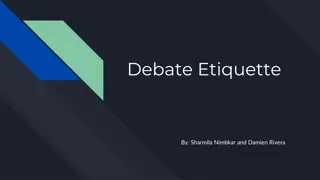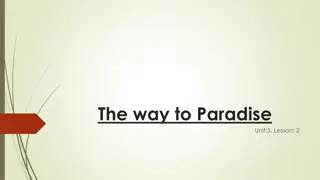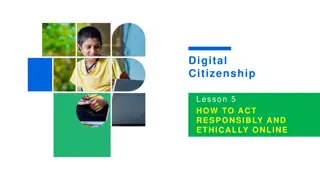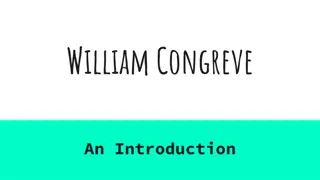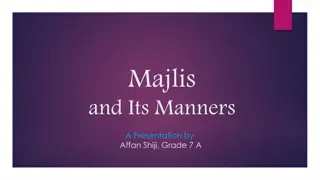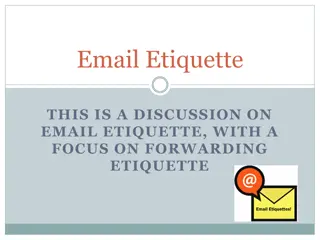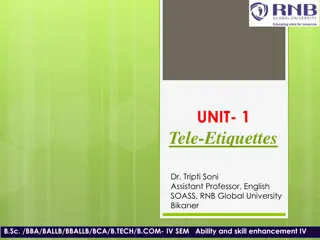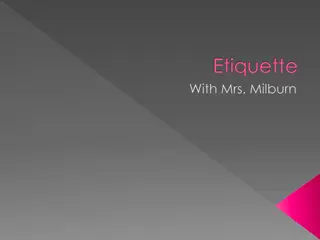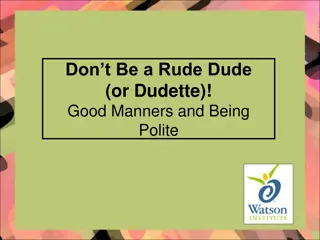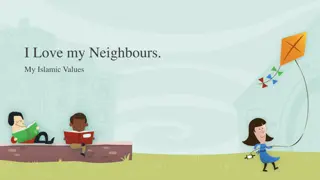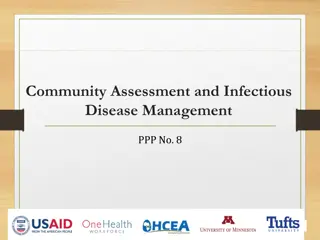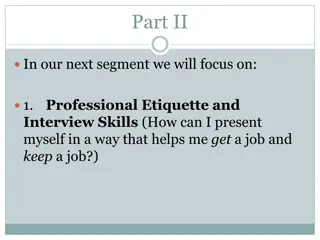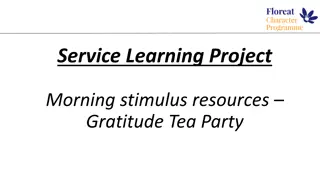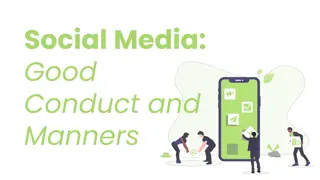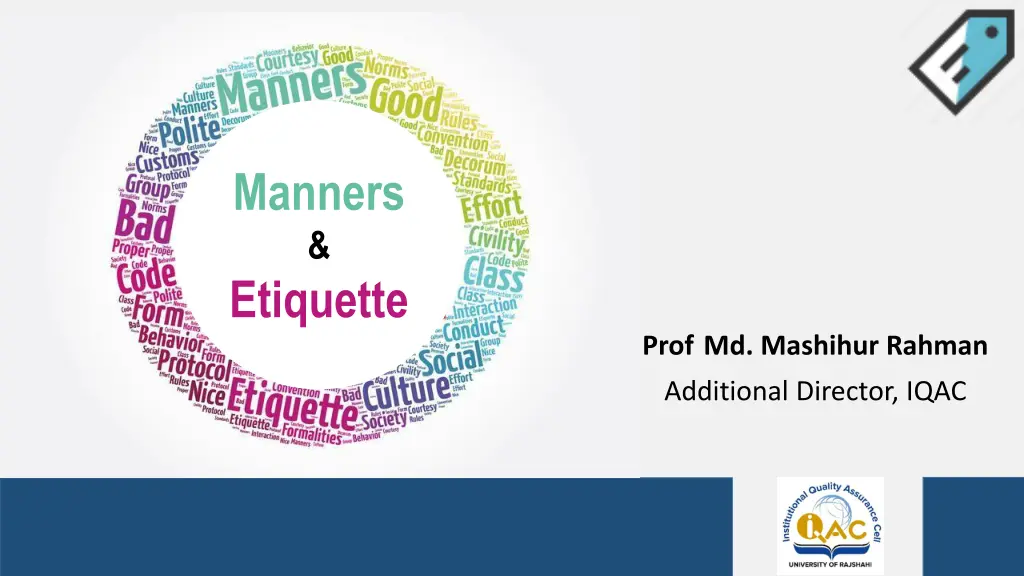
Understanding the Differences Between Manners and Etiquette
Explore the distinctions between manners and etiquette, how they shape behavior, and their impact on society. Learn about the benefits of good manners, various types of etiquette, and how they influence interactions in different social settings. Enhance your understanding of proper social conduct and its significance in personal and professional relationships.
Download Presentation

Please find below an Image/Link to download the presentation.
The content on the website is provided AS IS for your information and personal use only. It may not be sold, licensed, or shared on other websites without obtaining consent from the author. If you encounter any issues during the download, it is possible that the publisher has removed the file from their server.
You are allowed to download the files provided on this website for personal or commercial use, subject to the condition that they are used lawfully. All files are the property of their respective owners.
The content on the website is provided AS IS for your information and personal use only. It may not be sold, licensed, or shared on other websites without obtaining consent from the author.
E N D
Presentation Transcript
Manners & Etiquette ProfMd. Mashihur Rahman Additional Director, IQAC
Manners and Etiquette Both manners and etiquette revolve around human behaviour and are often used interchangeably, but two are different and shouldn t be confused. Manner is a way of behaving or conducting oneself, especially with respect to social norms and politeness. It is a way of behaving, especially towards other people, that is considered to be polite, respectful, or dignified. Manner reflects one s family background, education, home environment, commonsense, culture, human quality
Manners allow people to present himself/herself in a positive way to others. Etiquette is the customary code of polite behaviour in a society or among members of a particular profession or group. It typically involves the use of good manners and consideration for others.
Differences between Manners and Etiquette Manners are the basic general principles of politeness or polite behaviours and courtesies that we use in social situations and are expected of us in our day-to-day life. Etiquette on the other hand is a set of specific rules, regulations, and customs that are expected in particular social situations, often related to a certain profession or culture. Manners are a reflection of our character, etiquette is a reflection of our culture. Manners are more individual and can be adapted according to the situation While etiquette is more structured and should be followed exactly as it is laid out. Manners are flexible and can be adapted to different cultures, while etiquette is much more rigid and is often specific to a certain culture.
Students Teachers Community Members Different Offices Your Network Alumni YOU Administrators Guardians Colleagues Media
Benefits of Good Manners Makie a positive and lasting impression on others Strengthen relationships Improve self-confidence Avoid potential conflict Make a positive contribution to society Respect for yourself and those around you Give you a professional edge in the workplace Promote an atmosphere of tolerance and understanding. Promote civility and politeness in society.
Different Types of Etiquette Etiquette and manners go hand in hand. You will find several etiquette for different situations Social etiquette is the set of conventions and expectations governing how people should behave in social situations. It includes practices such as using polite language, making introductions, and respecting personal space.
Different Types of Etiquette Maintain eye contact. Smile and be friendly. Shake hands firmly Introductions Etiquette Speak clearly and confidently. Use the other person s name. Use correct titles and honorifics. Stand up for a formal introduction. Wait for the other person to introduce themselves first. Ask questions to show interest. Follow up with a thank you or goodbye.
Different Types of Etiquette Listen attentively and avoid interrupting Refrain from bringing up controversial topics or topics that make others uncomfortable Conersations Etiquette Speak with respect and avoid using offensive language. Be mindful of nonverbal cues Refrain from dominating/monopolizing the conversation Respect the other person's beliefs and opinions with an open mind Keep an open mind when engaging in conversations Be sure to ask questions and show genuine interest Be aware of the other person's time constraints
Different Types of Etiquette Always be polite and courteous to everyone you meet. Conersations Etiquette (Contn d) Use appropriate language and always be respectful. Address people by their names and appropriate titles. Respect other cultures, customs and beliefs. Offer others your full attention when they are speaking. Apologize when you make a mistake. Avoid gossiping or talking about others in a negative way. Refrain from engaging in overly personal conversations. Thank people for their help and kindness. Refrain from criticizing or complaining.
Different Types of Etiquette Be prompt and arrive to office on time Dress professionally Professional Etiquette Speak and act respectfully towards colleagues and clients Follow workplace policies and procedures Be mindful of body language Avoid gossip and negative conversations Show appreciation to colleagues, employees and customers Keep conversations professional Respect the confidentiality of information Follow up promptly after meetings Prioritize tasks efficiently.
Different Types of Etiquette Prioritize tasks efficiently. Professional Etiquette (Contn d) Take initiative when possible. Use polite language. Keep a positive attitude. Always be honest and ethical. Show appreciation for feedback. Listen attentively and be willing to learn. Stay organized. Demonstrate flexibility when needed.
Different Types of Etiquette Arrive Early: Get to the meeting on time, or even a few minutes early Greet Everyone (with a smile and a handshake) Meeting Etiquette Stay Focused and pay attention to the conversation, avoid checking your phone Participate: Contribute to the conversation by offering your opinion or feedback. Listen to what others are saying and ask relevant questions. Be Respectful of others opinions and maintain a supportive and friendly atmosphere. Keep the discussion on-topic and avoid deviating off-topic. Dress Appropriately and maintain a professional demeanour.
Different Types of Etiquette Dress appropriately and maintain a professional demeanour Meeting Etiquette (Cont d) Keep an open mind for new ideas and maintain a positive attitude Be prepared for the meeting with materials or information you may need Avoid interrupting, let the speaker finish their thought Ask questions to clarify points and make sure everyone is on the same page Take notes during the meeting so you can refer back to them later Take responsibility for any mistakes or misunderstandings
Different Types of Etiquette Respect others, be mindful of who you are speaking to and the environment you are in. Don t talk too loud Mobile Etiquette Turn off ringer/Use Vibration mode as per the situation/places Don t text/call and Drive Don t Call at Inappropriate Times Don t share personal information over the phone or text message. Be Courteous: Be polite and respectful in all of your conversations. Respect others equipment/privacy: Don t damage or tamper with or peep into other people s phones
Different Types of Etiquette Respect other users privacy Do not send unsolicited emails, or spam Network Etiquette Use appropriate language when communicating Be courteous when communicating with others Always use secure passwords Do not spread malicious content Treat others online as you would like to be treated. Be aware of cyberbullying and refrain from participating in it.
Different Types of Etiquette Network Etiquette (Cont d) Refrain from posting inappropriate content. Respect the intellectual property of others Refrain from posting false or misleading or unverified information Follow applicable laws and regulations. Refrain from engaging in illegal activities.
Different Types of Etiquette Dining etiquette refers to the rules of polite behavior one should follow while eating a meal. These rules may vary from culture to culture Keep your elbows off the table. Dining/Table Etiquette Don't speak with your mouth full. Wait until everyone has been served or seated before starting to eat. Use the utensils provided to you. Don't be overly loud or disruptive. Say please and thank you when ordering or when requesting something Place your napkin on your lap and keep it there throughout the
Different Types of Etiquette Chew with your mouth closed and don't talk with food in your mouth Dining/Table Etiquette Place your napkin on your lap and keep it there throughout the meal Respect the portion sizes served and don't take more than you need When you're finished eating, place your utensils on your plate in the "resting" position Don't leave the table until everyone is finished eating
Different Types of Etiquette Vehicle/Road Washroom Telephone Noise
Sorry Please Some good manners Thank you Hello You re welcome Excuse me



